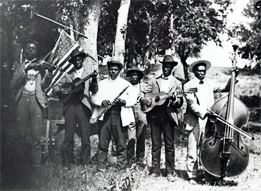 Fact #1: Following the issuing of the Emancipation Proclamation on January 1, 1863, not all enslaved people immediately found freedom.
Fact #1: Following the issuing of the Emancipation Proclamation on January 1, 1863, not all enslaved people immediately found freedom.
The Emancipation Proclamation freed slaves in states then in rebellion against the United States. Union troops operating in said states gave teeth to the Proclamation. This, however, did not apply to the border states.
Fact #2: The Civil War ended in the summer of 1865. Union General Gordon Granger and his troops traveled to Galveston, Texas to announce General Orders No. 3 on June 19, 1865. June 19th would go on to be known and celebrated as Juneteenth.
General Orders No. 3 stated: “The people of Texas are informed that, in accordance with a proclamation from the Executive of the United States, all slaves are free. This involves an absolute equality of personal rights and rights of property between former masters and slaves, and the connection heretofore existing between them becomes that between employer and hired labor.”
Fact #3: Part of General Order No. 3 encouraged the newly freed people to remain with their past owners.
“The freedmen are advised to remain quietly at their present homes and work for wages. They are informed that they will not be allowed to collect at military posts and that they will not be supported in idleness either there or elsewhere.”
Fact #4: The period after Juneteenth is known as the ‘Scatter.’
Undeterred by the recommendation to remain in place, many former slaves left the area during the original reading. In the following weeks formerly enslaved people left Texas in great numbers to find family members and make their way in the postbellum United States.
Fact #5: Juneteenth has been celebrated under many names.
Freedom Day, Jubilee Day, and Cel-Liberation Day, Second Independence Day, and Emancipation Day to name just a few.
Fact #6: Emancipation Park in Houston, Texas was bought specifically to celebrate Juneteenth.
The 10-acre parcel of land was purchased by former slaves, Richard Allen, Richard Brock, Jack Yates, and Elias Dibble for $800 in 1872.
Fact #7: During the early 20th-century Juneteenth celebrations declined.
The enactment of Jim Crow laws dampened the celebration of freedom. In addition, the Great Depression forced many black farming families away from rural areas and into urban environments to seek work— resulting in difficulty taking the day off to celebrate.
Fact #8: The celebration of Juneteenth was revived during the civil rights movement.
The Poor People’s March planned by Martin Luther King Jr. was purposely scheduled to coincide with the date. March participants took the celebrations back to their home states and soon the holiday was reborn.
Fact #9: Celebrations of Juneteenth continue today.
Traditions include public readings of the Emancipation Proclamation, singing traditional songs, and reading of works by noted African American writers. Celebrations can also take the form of rodeos, street fairs, cookouts, family reunions, park parties, historical reenactments, and Miss Juneteenth contests.
Fact #10: Forty-seven states and the District of Columbia recognize Juneteenth as either a state holiday or ceremonial holiday, a day of observance.
New Hampshire became the latest state to formally recognize Juneteenth in 2019.
1979 June 07; Texas Passes Bill Becoming the First State to Make Juneteenth a Holiday
What Is Juneteenth? How Did It Start? What Is Its Legacy?
Juneteenth … Meet Your New America!
On Juneteenth by Annette Gordon-Reed










